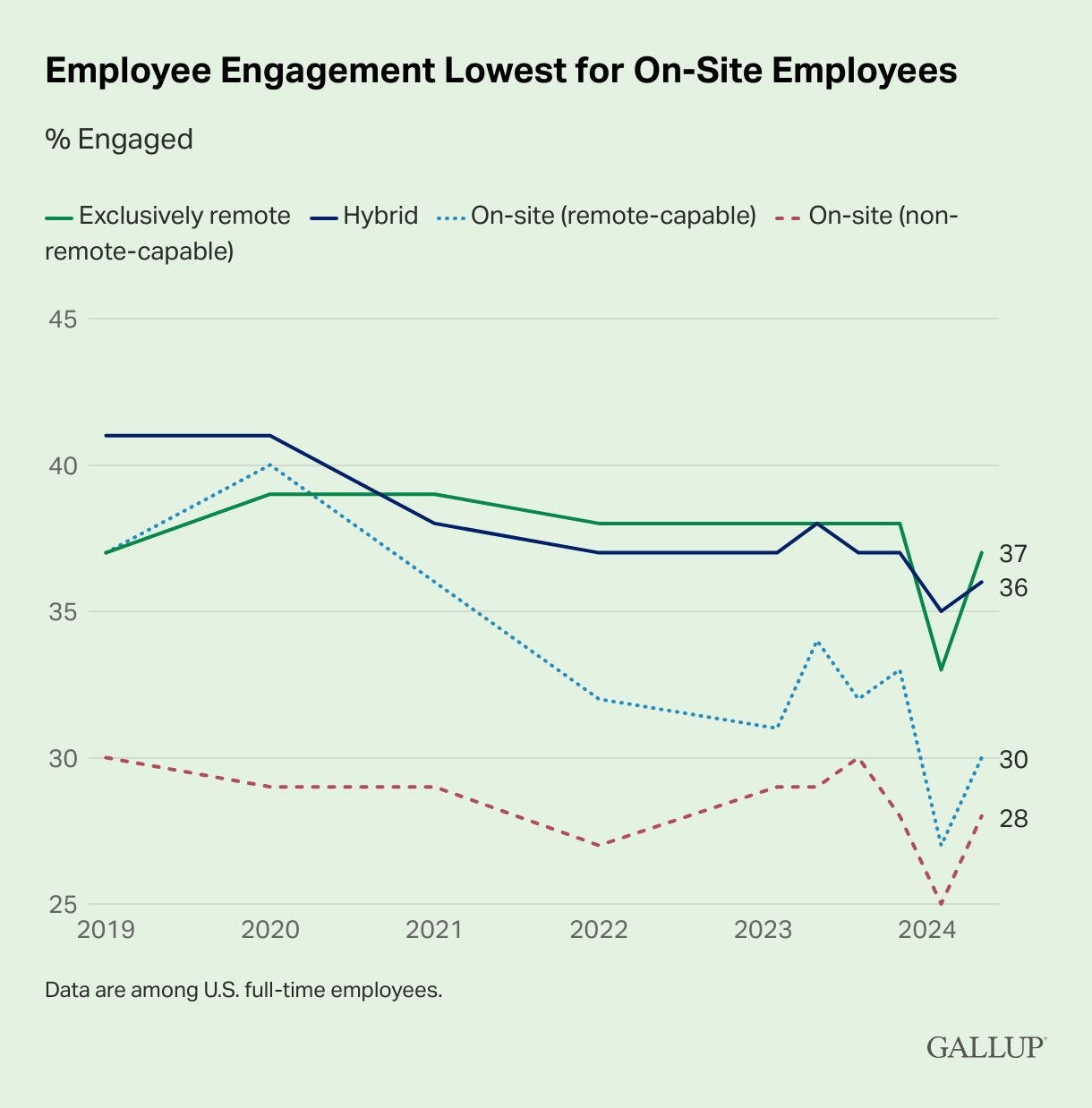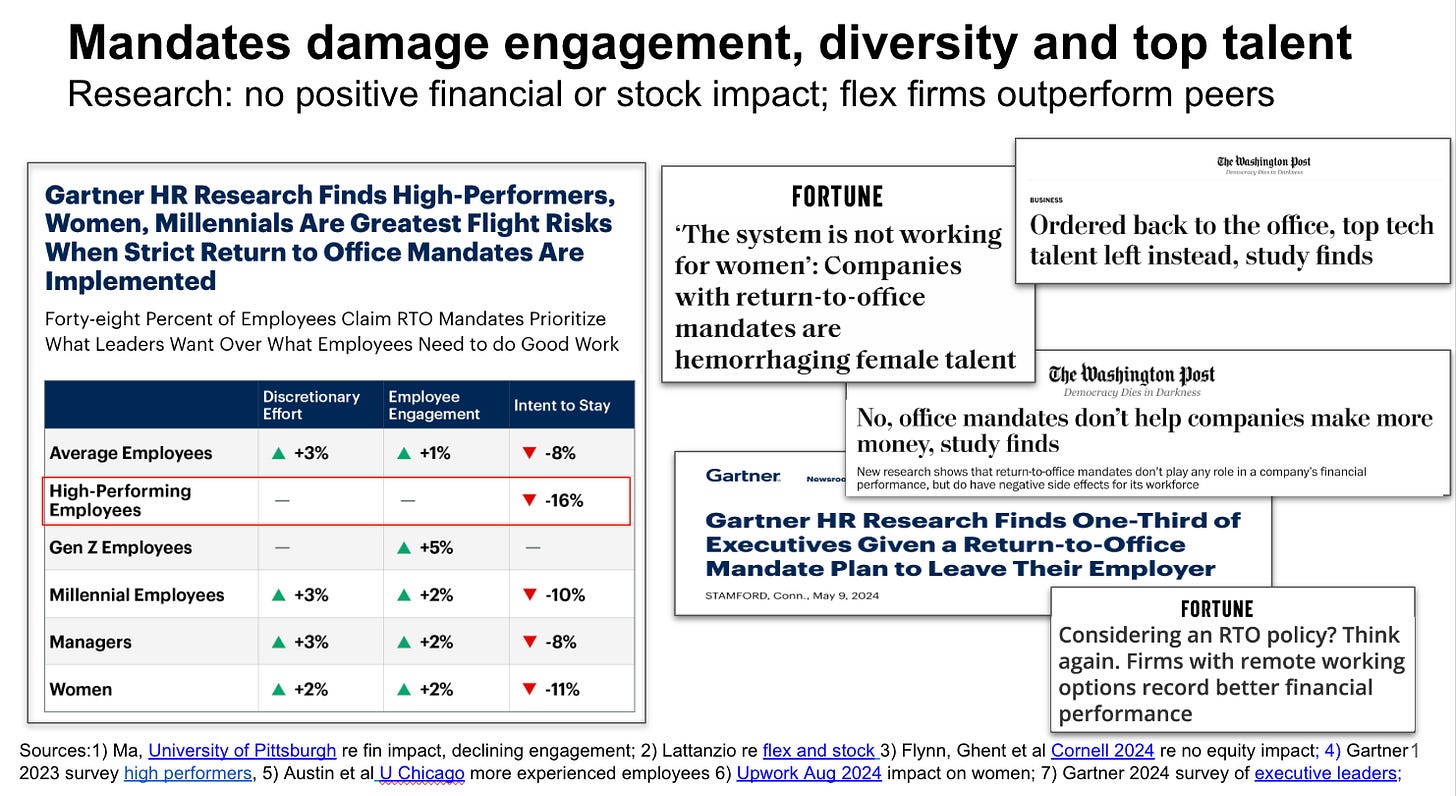I’ve had a lot of senior executives reaching out to me lately, grappling with the same challenge: their CEO is pushing for a return-to-office mandate. The conversation typically starts the same way: "Our CEO isn't happy with office attendance and wants everyone back."
This newsletter is based on what I’ve been sharing with them. First, we’ll cut through the noise and look at what's really happening in the workplace today. Then we’ll walk through five critical questions that CEOs should be thinking about before making a unitary decision.
The Real RTO Landscape: Not What You Think
While headlines might have you believing everyone's rushing back to five-day office weeks, the data tells a different story. My recent MIT Sloan interview about the performance impact of RTO mandates has garnered around 350,000 views – clearly striking a nerve. But here's what's not making headlines: most major companies aren't actually following the full-time return trend.
Take Citi's CEO Jane Fraser, who's notably bucking the trend (and yes, she's one of the few female CEOs in financial services). Or look at tech giants Google, Microsoft, and Meta, along with all of the Big Four accounting firms: they're sticking with hybrid approaches. Why? Because they want to keep talented people and are following the data – not the hype.
They’re not alone.
By the Numbers: What's Really Changed?
Let's break down the actual shifts we're seeing:
68% of US companies maintain flexible work policies, with no significant movement toward five-day office requirements in 2024 (Flex Index)
Among startups founded since 2010, 91% offer flexible work options (Flex Index)
US work-from-home rates sit at 28%, nearly 5X pre-pandemic levels (Bloom et al)
Office utilization increased just 3 percentage points in 2024, reaching only 32% in North America (CBRE)
Office vacancies and office mortgage delinquencies both hit all-time highs at the end of 2024
Even Amazon had to scale back its RTO plans in over 40 locations after cutting $1.3 billion in office commitments.
There’s not an overall tidal wave backwards to five days, but there is a clear push towards three days in Flex Index’s data. The strongest RTO pushes are coming from companies with significant commercial real estate interests or those using it as a stealth layoff strategy – just look at Dell's recent patterns.
The Trust Gap: It's Not About Productivity
Here's what many CEOs may not know: when they mandated three days in the office but only see two days of attendance, that's actually normal. Even pre-pandemic, the average office seat utilization was 50-60%. People were always out – visiting clients, on vacation, sick, or working flexibly.
CEOs may think that more time in office creates engagement, but the opposite is true: forcing people back five days a week actually reduces engagement. Gallup's data is crystal clear on this.
And if you're worried about losing talent, consider this: women are three times more likely than men to leave when faced with strict RTO mandates. Your most marketable, high-performing employees are the ones most likely to have options – and they're using them. The policy your CEO puts in place to address the 5% of your employees who are slackers also hits your highest performers.
The RTO mandate might get some Board members off his back, but it also doesn’t improve financial performance or stock market performance. Conversely, a recent study shows that highly flexible firms regularly outperform their peers and stock market expectations.
There are studies that show fully remote can be less productive, particularly if people aren’t managed for performance. The often-cited study showed 20% lower productivity. But they measured engineers in India during the peak of the pandemic – hardly a fair comparison to today's hybrid environment. Having worked with those teams who were tethering phones for connectivity, living in small apartments and grappling with the throes of the pandemic, it’s not a surprise it took them an hour long to finish their work in the summer of 2020.
Other studies, like HBS Professor Raj Choudhury’s work with the US Patent & Trademark Office, showed a 4% increase in productivity for remote workers. Stanford Professor Nick Bloom’s recent paper in Nature showed no impact on productivity, but 33% lower attrition for hybrid workers versus those full-time in offices.
The Big Question
That brings me to the most important question everyone should ask:
What problem are you trying to solve?
Words like culture, connection, collaboration are broad—get deeper on what’s underlying the concern. More often it’s just a fear that people aren’t really working hard enough when they’re not in the office. Dig into the data!
When There Are Real Performance Issues
Sometimes, there are legitimate concerns about remote work's impact on productivity, particularly with junior employees in sales or engineering roles. But let's be precise about the problem we're solving: how do we train, support and manage junior employees? More time together might be part of the solution, but it’s not the only factor.
A Better Approach: Five Key Questions for Leadership Teams
Before following the Jamie Dimon playbook, consider these five critical factors:
Are teams distributed, or co-located? Take a hard look at your actual team structures. Are they truly co-located, or are they distributed like roughly two-thirds of Microsoft's teams? If your engineering manager in Seattle is leading developers in Austin and Boston, a five-day RTO mandate won't magically create "water cooler moments" – it'll just breed resentment, and inhibit collaboration in distributed teams. The real question isn't about office attendance, it's about how to foster meaningful collaboration across locations.
How much pain are you creating? What percentage of your workforce lives within a 45-minute commute? The post-pandemic exodus to affordable housing is expensive to reverse at higher housing costs and 2X the mortgage. When you also factor in increased childcare expenses (try finding five-day coverage when you've been managing with two), and 1-2 hour daily commutes, you're not just asking for presence, you're demanding life upheaval. Is that battle worth fighting?
How are teams structured? Look closely at how your teams actually operate. Are they primarily functional teams working within their disciplines, or are they cross-functional project teams that form and reform based on business needs? Project-based work, whether it's product development, marketing campaigns, or systems redesign, benefits more from intentional gatherings around key milestones than from arbitrary daily presence. The most successful companies I've worked with focus on "moments that matter" – kickoffs that establish clear goals and working norms, milestone reviews that maintain momentum, and launches that celebrate shared success.
What’s your Employee Value Proposition (EVP)? What's your real competitive advantage in talent? If you're competing for highly engaged employees who deliver outstanding results, rigid RTO mandates send exactly the wrong message. The data consistently shows that flexibility is a critical component of engagement, especially for your highest performers. Unless you're paying significantly above market and have the brand cache of a Amazon or Goldman Sachs (and let's be honest, most don't), flexibility isn't just a perk – it's a core part of how top talent evaluates employers today.
Where should this decision get made? As one CEO recently told his leadership team: "Many of you would love me to say 3 days or 5 days is the answer. We're a global firm, with 5 business units, multiple functions and needs. I can't be the one answering that question – that's why you all have jobs." In a complex organization spanning multiple business units, countries, and functions, one-size-fits-all mandates often create more problems than they solve. The most effective approach is usually to establish clear principles and guidelines, then empower teams to create agreements that work for their specific context.
Making It Work: Real-World Solutions
Purpose-driven time together works – I’ve counseled companies that have sizably increased in-person time without backlash because the patterns make sense to employees. Here are two concrete examples of effective hybrid approaches:
Co-located Inside Sales: Generally more junior employees, everyone’s in 3 days a week, we do pitch practice sessions Tuesdays, Wednesday is pipeline review, Thursday is afternoon social. And you’re there because as a newer salesperson, you’ll learn from your peers.
Distributed Product Development: Major projects, the “big rocks” of the organization, gather teams at formation and for milestone reviews. Other teams have minimum quarterly gatherings so that all individual contributors are with teammates at least four times a year – alternating dedicated time for their functions (engineering, design, etc) and for cross-functional teams.
The shift to flexibility is also a massive opportunity to shift to outcomes-driven performance management. The lack of trust that people won’t slack off when working from home shouldn’t be solved by forcing them into offices (where they can slack off). Synchrony Financial’s CEO supports flexibility because they paired it with holding people accountable to results.
A Final Thought for Your CEO
If your organization struggles with the relatively modest shifts needed for flexible work, how will it handle the far more fundamental changes required for AI integration? The same principles of design hold: a focus on outcomes, willingness to experiment, investing in improving how people work, and building trust.
The future of work isn't about where we work – it's about how we work together for common purpose, build trust, and drive results. And if your leadership isn't ready for that conversation, maybe it's time to find one that is.
Want to dive deeper into making hybrid work? Check out my case studies on Allstate, Atlassian, and Zillow, or grab the free summary of "How the Future Works" for practical implementation steps.









I was listening to the We Not Me podcast yesterday with Jennifer Dulski (CEO of RisingTeam) and she made a powerful point: what % of CEOs demanding RTO are themselves in the office 5 days a week? More of than not, they're rarely there, adding another level of resentment from employees.
Great article, Brian.
3 days in is already too much IMO. It hurts my brain trying to understand how senior leaders can still think RTOs (and one size fits all approaches, while we’re at it) are a good idea after everything we’ve been through, and learnt during, the last 5 years in particular.
HRDs are also responsible for upping their game and working with their CEOs to come up with policies that serve the business and the people better.